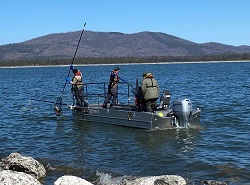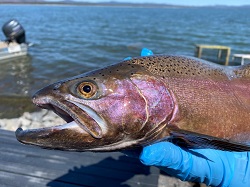Crystal Lake Hatchery Manager Tim Baker shows off a plump Eagle Lake rainbow trout prior to spawning lakeside this spring.


CDFW crews electrofish the shores of Eagle Lake to gather the rainbow trout needed for spawning.
For the third consecutive spring, fisheries biologists with the California Department of Fish and Wildlife (CDFW) have slowly trolled the mineral-rich waters of Eagle Lake in Lassen County in electrofishing boats, netting the stunned, sizeable rainbow trout that float to the surface.
Their progeny will help ensure the future of this unique native species and will support CDFW’s trout stocking efforts statewide. Eagle Lake rainbow trout (Oncorhynchus mykiss aquilarum) are the only trout species capable of surviving in Eagle Lake’s high alkaline, high pH waters. The subspecies of rainbow trout does especially well when stocked into less harsh environments throughout the state.
Spring electrofishing is becoming a new normal at Eagle Lake amid reoccurring drought and climate change. Dropping lake levels and low water flows have prevented the Eagle Lake rainbow trout from accessing their primary spawning grounds in the Pine Creek tributary and forced fisheries biologists to modify annual spawning activities.
CDFW has had to largely abandon its fish trap and egg collection station at Pine Creek, which in wet, snowy years feeds into the northwest sector of the huge lake, the second largest natural lake in California. Instead, for the past three springs, CDFW has set up a makeshift spawning facility lakeside at the Gallatin Marina, the one accessible boat launch left from which to launch CDFW’s electrofishing boats.
The lower 25 miles of Pine Creek is a seasonal stream with intermittent flows, part of the reason CDFW first established a fish trap and egg collection station there in the 1950s to help perpetuate a rainbow trout subspecies endemic to Eagle Lake.
Commercial fishing in the late 1800s and early 1900s combined with the diversion of Eagle Lake water for agricultural use and overall environmental degradation in the early part of the 20th century caused Eagle Lake’s rainbow trout population to plummet and spurred the need for human intervention.
Drought conditions and climate change in the 21st century are the latest challenges impacting the rainbow trout and their ability to access Pine Creek and spawn naturally.
The lower stretch of Pine Creek has had insufficient flows to accommodate spawning five times in the past 10 years. There was a striking absence of snow on the shores, roads and mountains surrounding the lake this spring when CDFW’s spawning operations took place.
In April, CDFW conducted a fish rescue in Pine Creek, removing more than 100 rainbow trout and combining the fish with those collected by the electrofishing efforts. All the fish were returned to Eagle Lake immediately after spawning.
During the course of its six-week spawning season, CDFW collected more than 1 million eggs and spawned 380 pairs of trout. The eggs were fertilized lakeside at Gallatin Marina and taken to CDFW’s Crystal Lake Hatchery in eastern Shasta County. Genetic diversity was carefully cataloged and maintained by spawning different year classes of fish on a one-fish-to-one-fish basis. Each year class of hatchery reared fish is identified by a distinguishing and different fin clip.
Of those offspring, 180,000 trout eventually will be returned to Eagle Lake in 2023 to support the destination sport fishery there.
The remainder of those eggs and trout will be distributed far and wide in one fashion or another – some as eggs shipped to other CDFW hatcheries, some of those as trout planted for recreational fishing, others raised and kept as broodstock in yet other CDFW hatcheries. Eagle Lake rainbow trout are stocked into 305 bodies of water in 48 counties for recreational fishing in places as diverse as McCoy Flat Reservoir in Lassen County and Chollas Lake Park in San Diego County.
“You put these fish anywhere else in less harsh conditions and they do really well,” explained Paul Divine, CDFW’s district fisheries biologist for Modoc and Lassen counties who has overseen spawning at Eagle Lake since 2008. “That’s another thing that makes them ideal for our hatchery program. You can pretty much plant them anywhere. They also live longer than a typical rainbow. We’ve seen fish in the 7- to 8-year-old class. The oldest one we’ve documented was 11 years old.”
The 1 million eggs collected this spring, however, means fewer Eagle Lake rainbow trout overall. In normal, non-drought years, CDFW is able to collect 1.5 to 2 million eggs from its Pine Creek facility.
Eagle Lake rainbow trout are one of 10 species of native trout that qualify for CDFW’s Heritage Trout Challenge, which recognizes anglers who catch California’s native trout in their historic watersheds.
Eagle Lake itself is rather unique in that it only supports native fish. The lake’s inhospitable waters have doomed the introductions of 11 different non-native species between 1879 and 1956, including largemouth bass, lake trout and catfish.
Within those waters, the Eagle Lake rainbow trout is joined by three species of native minnows and one native sucker – the Eagle Lake Tui Chub, speckled dace, Lahontan redside and the Tahoe sucker.
Eagle Lake opened to fishing May 28, 2022. Fishing will remain open through the last day in February 2023. Anglers are limited to two trout per day and four in possession with no special gear restrictions.
“They are super fun to catch. They are a great fighting fish,” said Divine. “And I don’t think you could find a better fish to put on the table. They are excellent to eat.”
Media Contact:
Peter Tira, CDFW Communications, (916) 215-3858